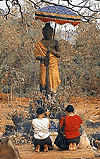 |
 |
|
| Story and Photos: Wiwat Pandawutiyanone |
|
 |
|
Situated 8 kilometers southeast of Champasak Province in southern
Laos, Wat Phu currently boasts structures impressively dating back as far as the 6th century. Yet there is strong evidence to suggest that even before that time, the mountain associated with the temple site, endowed with a permanent spring at its foot and peculiarly shaped like the phallic symbol (linga) of the Hindu God Shiva, was sacred to the local peoples centuries before the construction of the ruins currently visible. Whatever period is attributed to Wat Phu's origins - local history ascribes the construction of the temple site to a legendary King named Kammatha - clearly undisputed are its Hindu foundations and Khmer architectural designs, both strongly reflected by the remaining structures of Hindu deities and the distinctive sandstone composition of the temple buildings. |
 |
|
Wat Phu's present Buddhist affiliation is owed to its conversion to a Buddhist temple in much later years - some of the ruins currently found on the site were constructed by Lao monarchs in celebration of the annual Wat Phu festivals in the early 20th century. Today, thousands, the majority from Vientianne, Sawwanakhet, Salawan and Ubol Ratchathanee, still throng to the temple site every third lunar month of the year (Magha Puja) for their pilgrimage. Generally falling in the month of February, the pilgrimage to Wat Phu comprises ceremonial almsgiving and other Buddhist rites, and is followed by festivities that charge the compound with life, reminiscent of the splendor that once was.
|
| |
|
|
|